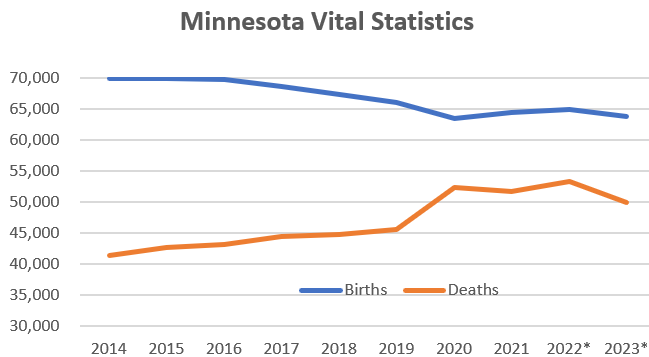Minnesota is in a demographic death spiral, cont’d
The latest data from the U.S. Census Bureau show little change in the state’s dismal population trends.
Alert readers will notice this post updates the one I wrote in December 2022, but with additional years of data. The overall situation has not improved.
The annual “natural change” in Minnesota’s population (births minus deaths) is not enough to compensate for the number of people moving out of the state. In the little over three years from the last census (April 1, 2020) to July 1, 2023, Minnesota saw a natural increase in residents of about 40,400. These gains were wiped out by the net domestic outmigration (people leaving Minnesota for other states) of 46,000. If not for the net “international migration” of 34,600, Minnesota’s overall population would have fallen over this period.
Digging into the natural increase side of the equation, here are the data for the past ten years, updated for the recent census estimates:

That same data graphed,

If you think of the recent peak year for births (2014) as the base year, that translates into more than 31,000 “missing” children over the past nine years.
Nowhere is this demographic shortfall more acutely felt than the Minneapolis school system. The Minneapolis Star Tribune posted this headline yesterday,
Minneapolis Public Schools faces a $115 million budget gap. Here’s what to know about possible cuts
Reductions are likely coming to programs and staff positions in schools and in the district office, but the final budget won’t be decided until June.
This massive shortfall comes despite schools being “fully funded” by last year’s state legislature. The MN Reformer takes a deeper dive in the city school situation. They report,
Official state figures from the fall of 2023 show that K-12 enrollment in Minneapolis public schools stood at around 28,000 students, a drop of 16% since before the pandemic and a staggering 43% since the dawn of the 21st century.
Various factors, including the rise of charter schools and open enrollment play a part. But the Reformer adds,
Part of the decline in recent years is strictly demographic. While stabilizing somewhat in the most recent data, Minneapolis’ overall population has fallen since the start of the pandemic.
“The number of students that we would need to be at full capacity don’t even exist in the city, because we have declining demographics,” Ibrahima Diop, MPS’ chief of finance, recently told MPR News.
Demography is destiny.